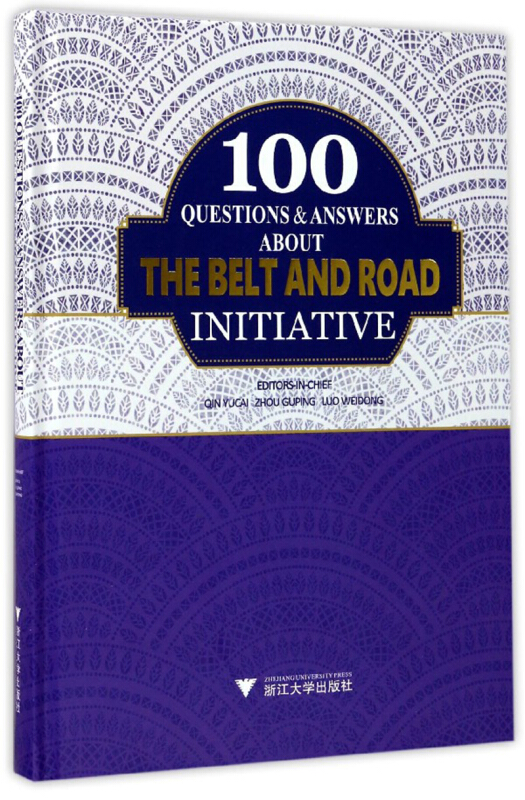- ISBN:9787308167246
- 装帧:一般胶版纸
- 册数:暂无
- 重量:暂无
- 开本:24cm
- 页数:180页
- 出版时间:2017-06-01
- 条形码:9787308167246 ; 978-7-308-16724-6
内容简介
秦玉才、周谷平、罗卫东主编的这本《一带一路一百问(英文版)》为“一带一路”知识普及读本,采用一问一答的形式,从百姓关心话题、时事政经热点出发,介绍“一带一路”国内外相关合作组织、相关行业信息等背景知识,分析“一带一路”带给相关行业的机遇和对百姓日常生活的影响,解答普通读者关心的现实问题。
目录
Introduction
1 What is the concept of the Belt and Road?
2 When was the concept of the Silk Road first proposed, and by whom?
3 What is the spirit of the Silk Road?
4 What are the epochal meanings of the Silk Road Spirit?
5 How shall we understand the spirit of "peace and cooperation, openness
and inclusiveness, mutual learning and mutual benefit"?
6 Why is it important to accelerate the Belt and Road's development?
7 What principles should be followed in building the Belt and Road, since it is a systematic project?
1 Strategic Conception
8 When was the Silk Road Economic Belt proposed?
9 When was the 21st-Century Maritime Silk Road proposed?
10 When was the Belt and Road Initiative elevated to a major state strategy?
11 Against what background was the Belt and Road Initiative proposed?
12 When was the Vision and Actions on Jointly Building Silk Road Economic
Belt and 21st-Century Maritime Silk Road published?
13 How many stages are there in formulating the Vision and Actions?
14 How many parts does the Vision and Actions cover?
2 Silk Road: A Brief History
15 What is the Silk Road?
16 When did China's silk come into being?
17 When was China's silk brought to the West?
18 Why did Zhang Qian go on diplomatic missions to the Western Regions?
19 What are the connotations and scope of the Western Regions?
20 What contributions did Pei Ju make to the Silk Road?
21 What contributions did Faxian, Xuanzang and Yijing, among other
Buddhist pilgrims, make to the Silk Road?
22 What is the relationship between the Battle of Talas and the Silk Road?
23 How did the Three Foreign Religions spread to China?
24 What influence did the Mongolian western expeditions have on the Silk Road?
25 Against what background did Richthofen propose the idea of the "Silk Road"?
3 Competition Between Great Powers
26 What are the strategies or initiatives of other countries that are similar to the Belt and Road Initiative?
27 What is the New Silk Road Initiative?
28 What is the Eurasian Economic Union?
29 What is the European Union's Partnership with Central Asia?
……
4 Background
5 Framework
6 Cooperation Areas
7 Mechanisms and Platforms
8 Advantages of Various Regions in China
9 Cooperation Results
10 Vision and Outlook
References
Appendix
Postscript
节选
《“一带一路”一百问(英文版)》: APEC and ASEAN (10+3) are typical examples.Currently, APEC has 21 members across North America, South America, East Asia and Oceania.There are developed industrial countries and developing countries.APEC discusses the issues concerning global and regional economies.It is continuously making progress in promoting regional trade and investment liberalization and facilitation, and playing an active role in driving global and regional economic growth. ASEAN has not only promoted cooperation between the countries within the region, but also promoted the cooperation between ASEAN members and China, Japan, and the Republic of Korea.ASEAN aims to make joint efforts to promote regional economic growth, social advancement and cultural development, and lay a foundation for building a prosperous and peaceful community of Southeast Asian countries, thereby promoting peace and stability of the region.From the 1990s, ASEAN gradually began "export—oriented economic cooperation," forming various cooperation mechanisms at differentiated levels, such as the "10+1" and "10+3" mechanisms."10+1" and "10+3" refer to, respectively, the mechanisms in which ASEAN cooperates with China, Japan and the Republic of Korea separately (i.e., three "10+1"s) and with the three countries as a whole.The "10+1" and "10+3" cooperation mechanisms focus on economic cooperation and are gradually expanding to the areas of politics, security and culture, having formed a reasonable layout at multiple levels in a wide scope.The "10+1" mechanism defines five key cooperation areas: agriculture, information communications, human resources development, mutual investment and development of the Mekong River region.The eight key areas for cooperation covered by the "10+3" mechanism are economy, currency and finance, development of social and human resources, science and technology, development cooperation, culture and information, political security, and transnational issues. ……
作者简介
秦玉才,党员,1982年毕业于东北林业大学本科,2000年中南财经大学在职博士。原任国家发改委西部开发司司长。
-

国富论
¥8.8¥35.0 -

曾国藩的经济课
¥26.5¥68.0 -

博弈论
¥10.0¥38.0 -

看得懂的经济学-哈佛教授最受欢迎的经济学课
¥19.7¥58.0 -

斯密评传
¥14.4¥45.0 -

图解资本论
¥12.2¥46.0 -

经济学通俗读物:北大经济课(受益一生的经济学智慧)
¥11.6¥35.0 -

1949-2009-八次危机-中国的真实经验
¥31.9¥55.0 -

元代榷盐与社会(2009/8)
¥9.9¥30.0 -

资本论
¥27.5¥59.8 -

博弈论
¥25.9¥49.8 -

财富从哪来
¥23.4¥65.0 -

中世纪商业合伙史
¥16.7¥49.0 -

经济学通识-第二版
¥20.3¥58.0 -

日本的反省-走向没落的经济大国
¥12.6¥35.0 -

思考.快与慢
¥50.4¥69.0 -

行为经济学要义
¥28.3¥59.0 -

星际迷航经济学 科幻、经济学和未来世界
¥20.0¥49.8 -

英国的经济组织
¥16.9¥18.0 -

1965-2005-美国外来移民的劳动力市场与经济影响
¥22.0¥58.0














